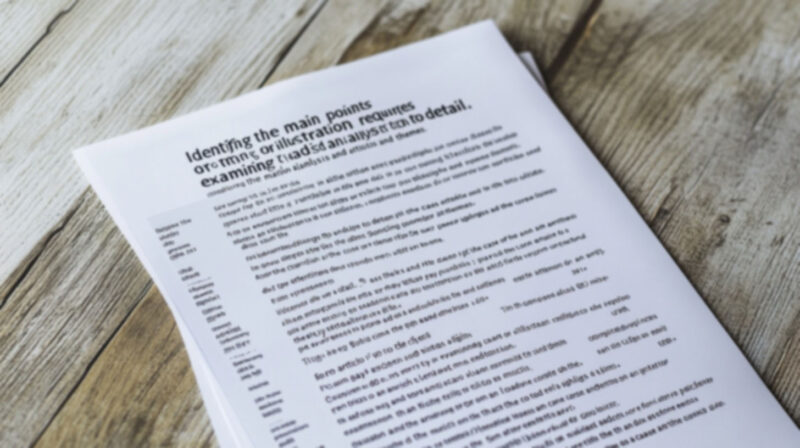Identifying the main points in an article or illustration is a crucial skill for efficiently processing information. By focusing on key ideas and essential details, readers can grasp the core message without being overwhelmed by unnecessary elements.
It not only enhances comprehension but also saves time, making it particularly valuable for students, professionals, and anyone seeking clarity in written or visual content.
That is why we want to provide practical techniques to pinpoint and summarize the main ideas effectively, ensuring a clear and concise takeaway.
The Importance of Headlines and Titles

The headline or title of an article provides the first indication of its main topic, acting as a gateway to the content that follows.
Writers typically design headlines to summarize the central focus of their piece, offering readers an initial understanding of the subject matter.
It makes the headline a critical starting point for identifying the main points.
- Headlines often outline the subject or theme, such as “economic growth,” signaling what the article will discuss.
- A good headline provides insight into the content’s tone, structure, or intent.
- By starting with the title, readers can align their thoughts and track the flow of ideas throughout the article.
However, it’s important to approach headlines critically. Not all titles are straightforward, and some may prioritize being attention-grabbing over being descriptive.
For example, a headline like “The Future of Work is Here” may hint at trends in remote work or emerging technologies but doesn’t provide specifics.
Readers must go deeper to connect the title to the article’s actual content.
- Look for key phrases that indicate the article’s primary focus, such as “causes,” “solutions,” or “trends.”
- Match the headline to the ideas presented in the paragraphs to confirm its relevance.
- A straightforward headline typically reflects factual reporting, while a more dramatic one might indicate opinion or analysis.
By treating the headline as a guidepost rather than a definitive summary, readers can better navigate the article.
Identifying Key Sentences

Key sentences are the backbone of an article, often delivering the most essential information. These sentences are typically located at the beginning or end of a paragraph, where they introduce or summarize important ideas.
Carefully reading and paying close attention to recurring patterns or signals can help pinpoint these critical sentences effectively.
- Look for phrases or ideas repeated throughout the article. For instance, a piece on climate change might emphasize terms like “sustainability” or “carbon emissions” multiple times, signaling their importance.
- Phrases such as “in conclusion,” “most importantly,” or “the main takeaway” often precede key sentences, indicating their significance.
- Many paragraphs begin with a topic sentence that outlines the main idea, followed by supporting evidence or examples.
- Key sentences usually tie directly to the overall theme or focus presented in the headline. Ensure the sentences you highlight align with the central topic.
Additionally, avoid focusing too much on minor details, as these often serve as supporting evidence rather than the main ideas.
Use methods like highlighting or underlining to make these sentences stand out, ensuring a systematic and efficient approach to reading and analysis.
Recognizing Topic Sentences

Topic sentences play a critical role in the structure of an article, as they provide a clear indication of the main idea each paragraph will address.
Typically placed at the beginning of a paragraph, a topic sentence acts as a roadmap for what follows, guiding the reader through the core concepts being discussed.
A well-crafted topic sentence is direct and to the point, outlining the paragraph’s purpose.
- In an article about mental health, a paragraph might open with: “Regular exercise improves mental health.”
- The remaining sentences would then expand on this idea, providing evidence, examples, or data to support it.
Key characteristics of topic sentences:
- They introduce the main idea of a paragraph.
- Often found at the beginning of a paragraph, but not always.
- Provide a summary of the paragraph’s content.
- Use clear, concise language.
Tips for identifying topic sentences:
- Look for sentences that introduce a broad concept, which is then elaborated on in the rest of the paragraph.
- Watch for phrases signaling importance, such as “The primary reason,” “One key aspect,” or “A significant factor.”
- If a paragraph begins with an anecdote or example, the topic sentence may appear later, summarizing the idea conveyed by the example.
However, it’s important to note that not all paragraphs will strictly adhere to this pattern. Some paragraphs may start with a specific detail or example and present the topic sentence further down.
Separating Main Points from Supporting Details

One of the most important yet challenging aspects of analyzing an article is distinguishing between main points and supporting details. The main points represent the article’s core ideas, often forming the foundation of the writer’s argument or message.
Supporting details, on the other hand, are the pieces of evidence, examples, or explanations used to strengthen and clarify those main points.
Understanding this distinction allows readers to focus on the most essential aspects of the article without getting bogged down by additional information.
| Characteristics | Main Points | Supporting Details |
|---|---|---|
| Purpose | Provide the central message or argument of the article | Justify, explain, or provide evidence for the main points |
| Relation to Headline/Title | Are usually directly related to the headline or title | Complement the main points by adding context, examples, or explanations |
| Placement | Often found in topic sentences or as recurring themes throughout the article | Found within the body of the paragraph, often following the main point |
| Nature | Represent broad, overarching ideas rather than specifics | Include data, statistics, quotes, anecdotes, or case studies |
| Level of Detail | Focus on high-level, overarching concepts | Are typically more specific and detailed |
- A main point might be: “Improving teacher training is crucial for student success.”
- Supporting details could include: “A recent study found that teachers with advanced training methods improved student test scores by 25%,” or “Case studies from Finland’s education system show how teacher development leads to better outcomes.”
The Bottom Line
Mastering the skill of identifying and summarizing the main points in an article is invaluable for students and professionals alike.
By following the outlined steps, readers can effectively process information and extract meaningful insights with ease.







